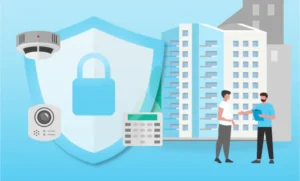Managing entry points can be challenging for property managers and staff members. Whether the property has a single driveway or multiple entryways, knowing who comes and goes is critical to maintaining operations.
As such, gate access control systems can serve as a very effective method in managing traffic flow to and from property gates. Furthermore, these systems help regulate access through automated processes, allowing property managers and building owners to create access policies that reflect their specific needs.
Components of a gate access control system
Gate access control setups typically involve a few interconnected components. Together, these parts create a workflow that grants or denies access based on credentials that are already logged in a system’s directory.
1. Credentials
The first thing to consider is how users will gain access.
Most systems support one or more of the following:
- Keycards or fobs: Often used in commercial and residential settings, keycards and fobs contain RFID chips that communicate with the access reader.
- PIN codes: For properties that prefer not to distribute keys or cards, PIN codes offer a contactless option.
- Mobile credentials: A growing number of access systems allow residents or staff to enter using their smartphones. These often involve a mobile app or Bluetooth/NFC pairing.
- Remote clickers: Commonly used in gated communities, these resemble garage door openers and allow authorized vehicles to open gates from a distance.
2. Readers
Access readers are installed near entry points, typically at a vehicle gate or pedestrian door, and are the first physical interface users will encounter.
Depending on the type of credential being used, readers can take different forms:
- RFID readers for cards and fobs.
- Keypads for numeric input.
- Mobile readers using Bluetooth or NFC.
3. Gate operators
A gate operator is the mechanism that physically opens and closes the gate. Some operators work by swinging the gate open, while others slide it along a track. These operators receive a signal from the access reader and respond accordingly. Their size, speed, and power requirements depend on the type and size of the gate.
4. Control panel
Behind the scenes, a control panel manages user permissions. However, in more modern setups, a cloud-based access dashboard is used instead of a traditional control panel. A dashboard like this will store access credentials, maintain entry logs, and empower property staff to add or remove access remotely.
Benefits of using a gate access control system
More oversight
Gate access control systems track when residents, staff, or visitors enter or exit the property. With cloud-based or connected systems, this information is stored in entry logs that can be reviewed if an incident occurs or if a resident reports suspicious activity.
Reduced staffing needs
Instead of hiring security personnel to guard gates, or relying on physical PINs or keyfobs, access systems can help automate the process and reduce the need for more man-power. While they don’t remove the need for human oversight, they can still reduce dependency on staff for day-to-day entry management.
Visitor entry
Some access control systems for gates offer features like virtual keys, temporary PIN codes, or intercom-based visitor management that improve visitor management operations. Moreover, they allow residents or staff to remotely grant access without creating a security vulnerability at the gate.
Flexible access permissions
With the right gate access system, property managers can assign access credential levels based on time of day, user group, or gate location. For example, delivery drivers might be allowed in through a service entrance during working hours, while residents and their credentialed guests have 24/7 access.
What to consider when choosing a gate access control system
Before buying a gated access control system, there are a few factors to keep in mind when deciding which system fits your needs best.
These considerations help make sure that your investment meets both short-term requirements and longer-term planning:
- Property layout: Gated communities with separate entrances and exits may need a system that can manage multiple gates under a unified dashboard. For instance, apartment complexes may only have a single entry gate, but with additional controls for resident access.
- Number of users: Another important consideration is the size of the resident or tenant population. Systems with limited user capacity may be more suitable for small properties, while larger buildings benefit from systems that can scale easily without excessive costs or complexity.
- Integration with other systems: For properties already using intercoms or cloud-based building management software, it’s important to choose a gate access system that easily integrates with these systems. As such, compatibility with these platforms can reduce complications and simplify workflows.
- Type of gate: Since each gate type has specific motor and control panel requirements, a gate operator needs to be compatible with the physical structure and frequency of use. For instance, a heavily used commercial vehicle entrance may require a more durable and responsive system.
- Access control preferences: Lastly, some residents might have different comfort levels with technology. In some buildings, mobile access may be well-received, while others may prefer the familiarity of cards or keypads. Understanding your user base can help avoid frustration down the line.
Conclusion
Choosing the right gate access control system is crucial, and can often have an impact on the security and comfort residents and their guests. But, by keeping in mind the benefits and considerations listed above, buying a gate system doesn’t have to be too complicated.
Lastly, installing a gate access control system is a strategic move towards increasing property security and enhancing resident satisfaction that you won’t regret.

